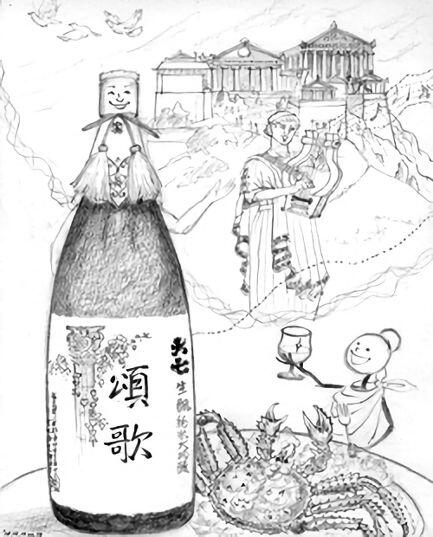| Yeast |
“Today I’m going to visit Shoka. Hello!” |
|
 |
| Shoka |
“Hey, Yeast, welcome, I’ve been expecting you.” |
| Yeast |
“Shoka, am I right that you are a high-end free run drops junmai daiginjo, even one place higher in rank than our popular junmai daiginjo Minowamon?” |
| Shoka |
“Right. I was born by taking the best of my parent, Minowamon, and applying a special process to that. If you compare me to tuna fish, I would be the precious fatty part called otoro.” |
| Yeast |
“I see! What’s the origin of your name?” |
| Shoka |
“Shoka is the Japanese translation of the word ‘Ode,’ a song of praise to extol the glories of deities or the great deeds of heroes, such as were written by poets from ancient Greece and Rome, as Horace.” |
| Yeast |
“Now I understand why the pillars of a Greek temple are pictured on the label!” |
| Shoka |
“Clever that you have noticed! Don’t you think they fit remarkably well to the Japanese-style design?” |
| Yeast |
“Yes, the glittering red and silver give a sort of sacred atmosphere to it.” |
| Shoka |
“In Japan, red and white are the colors of auspicious occasions and good luck. I’m very suitable as a gift on festive occasions and to persons to whom one wants to express gratitude. But of course the most auspicious thing is that I am so delicious, as everyone says!” |
| Yeast |
“Sure, you are the free run drops junmai daiginjo which is the pride of Daishichi! By the way, what is that exactly, a free run drops sake?” |
| Shoka |
“Don’t you know? Normally when separating the sake from the lees, a certain amount of pressure is applied by using a press, but in the case of free run drops or shizuku sake, the mash is put in bags and the sake naturally drips out under its own weight. This results in sake with more clarity and a higher fragrance than sake which has been pressed.” |
| Yeast |
“Oh yes, I remember. As it takes time for the sake to drip down naturally, and as only a small amount of sake can be generated in this way, it leads to very precious sake.” |
| Shoka |
“Indeed. But the process shouldn’t take too much time, either, because the delicate sake will oxidize when it is too long exposed to air. It takes a lot of effort to speed up the process so that the sake doesn’t oxidize.” |
| Yeast |
“For the master brewer and his staff it’s hard work to make delicious sake! By the way, which food fits to you, Shoka?” |
| Shoka |
“Best are dishes with a soft umami, such as boiled king crab or fish with white meat. I can also recommend creamy dishes and dishes with egg. Drink me cold at 10-12 °C.” |
| Yeast |
“That sounds really delicious! I hope many people will try you out!” |
| Shoka |
“Yes, especially since this year I have also appeared in the popular size of 720 ml. Now I’m not only used as a gift, but more and more customers have started drinking me at home as their favorite sake.” |
| Yeast |
“How would you describe your taste in a few words?” |
| Shoka |
“My overall theme is the harmony between power and gracefulness. Besides my smooth and elegant taste which is the result of the super-flat rice polishing method which removes all off-flavors, my main characteristic is a well-defined umami.” |
| Yeast |
“We don’t see you so often yet, as you are only known to connoisseurs, but as the brother of frequent first prize winner Minowamon, it’s a sure thing that you’re delicious!” |





